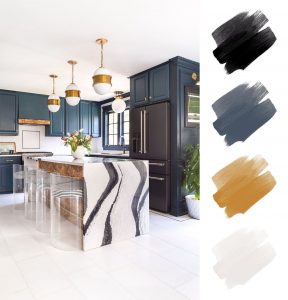If you’re staring at those outdated kitchen cabinets wondering how to transform your space without a complete renovation, you’re not alone. Cabinet painting has emerged as one of the most cost-effective ways to modernize your home, and the results can be truly remarkable. You’ll find that what once seemed like an intimidating task can become an achievable transformation, whether you’re considering tackling it yourself or hiring professionals. From classic whites to bold navy blues, today’s trending cabinet colors don’t just update your space—they create an entirely new atmosphere that reflects your personal style. Let’s explore how you can make this dramatic change in your home.
Popular Cabinet Color Trends
Cabinet color trends have shifted dramatically in recent years, moving away from traditional wood stains toward bold paint choices that transform kitchen and bathroom spaces. You’ll find crisp whites and soft grays dominating modern designs, while navy blue and sage green emerge as popular accent choices. For two-tone approaches, you’ll often see darker lower cabinets paired with lighter uppers, creating visual depth and interest.
Essential Tools and Materials
A successful cabinet painting project demands a specific set of professional-grade tools and materials to achieve durable, factory-like results. You’ll need a degreasing agent, TSP substitute, orbital sander with 120-220 grit paper, tack cloth, high-density foam rollers, quality synthetic brushes, bonding primer, and cabinet-grade enamel paint. Don’t forget painter’s tape, drop cloths, and a HVAC-grade filter mask.
Prep Steps for Success
Proper preparation stands as the cornerstone of any professional cabinet refinishing project. You’ll need to remove all hardware, label doors and drawers, and thoroughly clean surfaces with TSP degreaser. Next, sand with 120-grit paper, wipe with tack cloth, and fill any holes or dings with wood putty. Finally, mask adjacent surfaces and lay drop cloths to protect your work area.
Professional Vs DIY Painting
When deciding between professional cabinet painting and a DIY approach, you’ll need to weigh several critical factors. Professional painters offer specialized equipment, HVAC-controlled environments, and factory-like finishes, but at premium costs. DIY requires significant time investment and technical expertise with HVLP sprayers, but saves money. Consider lacquer versus water-based finishes, proper atomization settings, and your comfort with precision masking techniques.
 straightforward as it seems. Your selection needs to complement your home’s architectural style, mesh with existing elements, and reflect current design trends without appearing dated in a few years. While the options might feel overwhelming at first – from classic whites to bold navy blues and trending sage greens – understanding a few key principles will help you navigate this important decision. Let’s explore how to select cabinet colors that’ll create your dream kitchen while adding lasting value to your home.
straightforward as it seems. Your selection needs to complement your home’s architectural style, mesh with existing elements, and reflect current design trends without appearing dated in a few years. While the options might feel overwhelming at first – from classic whites to bold navy blues and trending sage greens – understanding a few key principles will help you navigate this important decision. Let’s explore how to select cabinet colors that’ll create your dream kitchen while adding lasting value to your home.